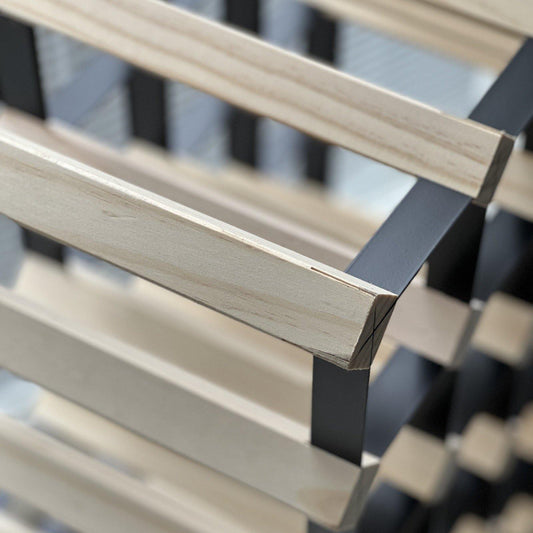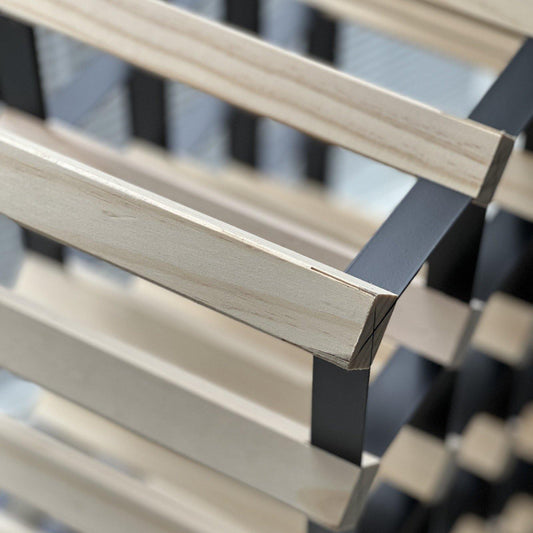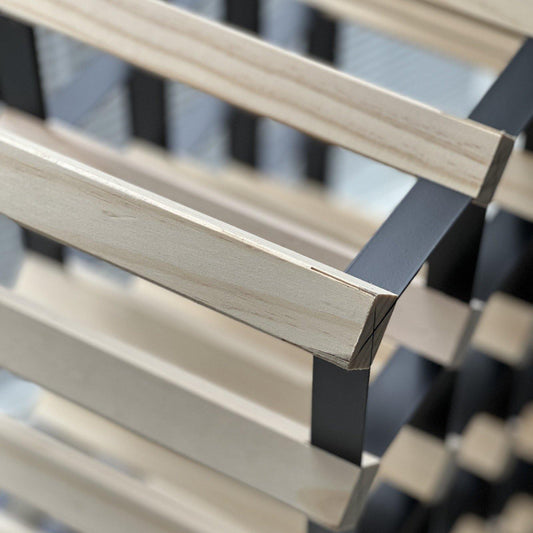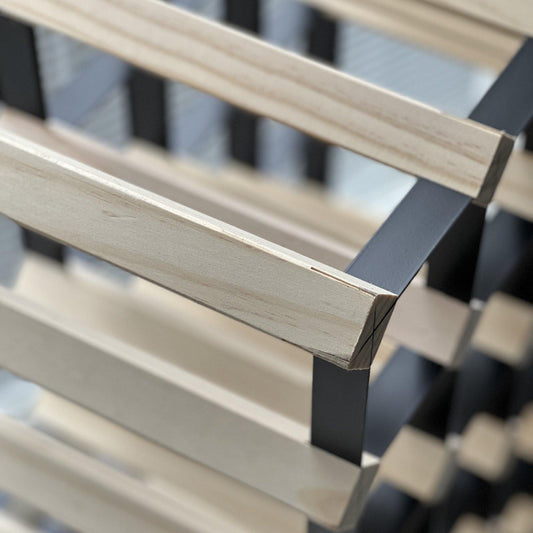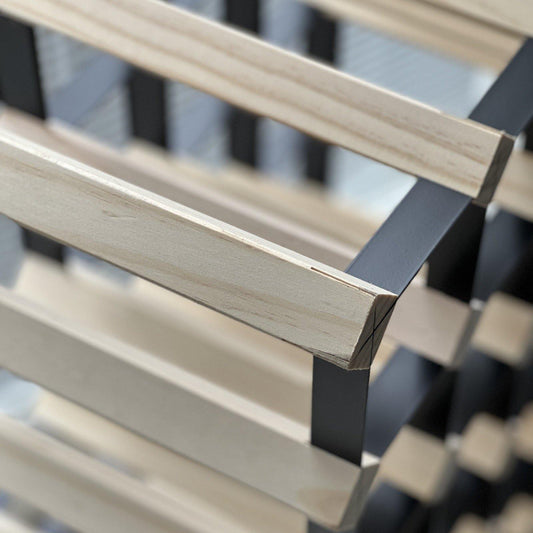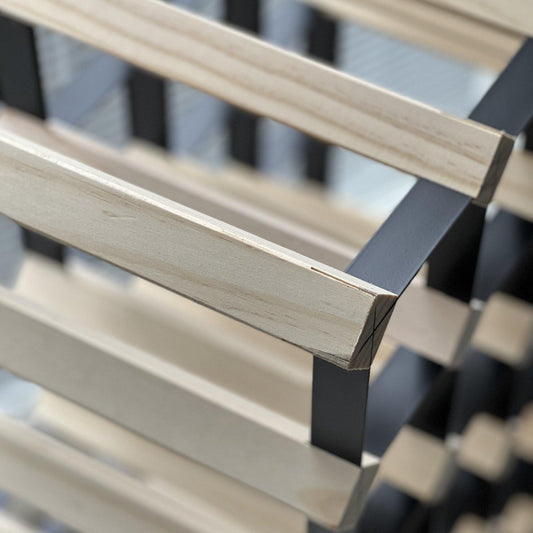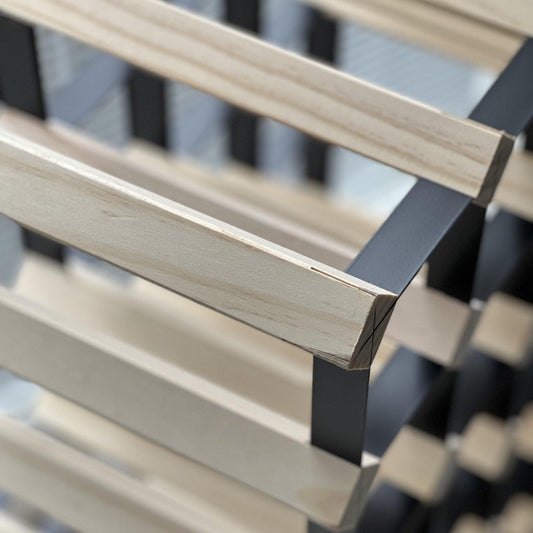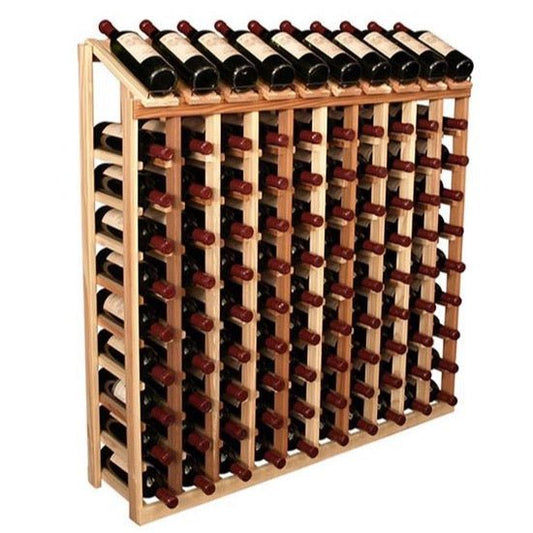Hardwood Wine Racks
When you invest in a quality wine collection, your storage should match that commitment. Hardwood wine racks offer superior strength, lasting beauty and the durability serious collectors demand. Built from dense, slow-growing timber, these wooden wine racks protect your bottles while adding warmth and character to your home. This guide helps you understand why hardwood remains the preferred choice for premium wine storage.
How to Choose a Hardwood Wine Rack for Long-Term Storage
Selecting the right hardwood wine rack ensures your investment serves you for decades. Consider these essential factors before purchasing.
Assess construction quality. Premium hardwood wine racks feature mortise and tenon joinery or sturdy dowel connections rather than screws alone. These traditional techniques allow natural wood movement while maintaining structural integrity.
Match capacity to your collection. Hardwood wine racks represent a significant investment, so choose a size accommodating both your current bottles and anticipated growth. Undersizing leads to costly upgrades, while oversizing wastes valuable space.
Consider your environment. Hardwood performs beautifully in temperature-controlled cellars, but also suits living spaces where you want furniture-grade appearance. The natural density of hardwood resists warping better than softwood alternatives in varying conditions.
Evaluate the finish. Hardwood wine racks come in natural, stained and lacquered finishes. Natural finishes showcase the timber's authentic grain, while stains allow you to coordinate with existing furniture. Lacquered options provide additional moisture protection for humid cellar environments.
Why Hardwood Outperforms Other Timber for Wine Storage
Hardwood comes from slow-growing deciduous trees, producing denser timber with tighter grain structure. This density translates directly to superior wine rack performance.
- Exceptional load capacity: A fully stocked hardwood wine rack supports hundreds of kilograms without bowing or sagging. The dense fibre structure distributes weight evenly across joints and shelves.
- Humidity resistance: Tight grain patterns limit moisture penetration, reducing swelling and warping in cellar environments where humidity fluctuates.
- Scratch and dent resistance: The hard surface withstands daily use, bottle sliding and minor impacts without showing wear.
- Longevity: Quality hardwood wine racks last generations. Your investment today becomes tomorrow's heirloom.
For collections exceeding 100 bottles or dedicated cellar rack installations, hardwood justifies its higher cost through superior longevity and performance.
Hardwood vs Softwood Wine Racks: Which Lasts Longer
The choice between hardwood and softwood affects your wine rack's lifespan, load capacity and long-term value.
Hardwood advantages: Dense timber structure supports heavier loads without sagging. A fully stocked hardwood wine rack maintains its shape for generations. The tight grain resists denting, scratching and moisture penetration better than softer alternatives.
Softwood considerations: Pine wine racks cost significantly less and suit lighter collections or temporary storage needs. Quality pine performs well for decades with proper care, though it may show wear more quickly than hardwood under heavy use.
| Feature | Hardwood Wine Racks | Softwood Wine Racks |
|---|---|---|
| Durability | Exceptional (50+ years) | Good (20-30 years) |
| Load Capacity | Superior | Moderate |
| Scratch Resistance | High | Lower |
| Price Point | Premium | Affordable |
| Best For | Permanent cellars, large collections | Starter collections, budget storage |
If you prefer the lighter appearance and budget-friendly pricing of softwood, explore our classic wine rack collection for quality alternatives.
Hardwood Wine Cube Dimensions and Bottle Capacity
Hardwood wine cubes offer versatile, stackable storage that adapts to any space. Understanding dimensions helps you plan your configuration effectively.
Standard wine cube sizing: Most hardwood wine cubes measure approximately 50cm per side, accommodating 12 to 24 bottles depending on internal divider configuration. These modular units stack vertically or arrange horizontally to fill available space.
Individual bottle cells: Quality hardwood wine cubes feature cells measuring roughly 9cm square, sized perfectly for standard Bordeaux bottles. Larger format bottles like Champagne or Burgundy require wider cell configurations.
Planning your layout: Calculate your total bottle capacity by multiplying cube count by bottles per cube. Leave 5cm clearance above stacked cubes for bottle insertion. Wall-mounted configurations require appropriate fixings rated for the combined weight of cubes and bottles.
Hardwood wine cubes excel in modular cellar builds. Their structural strength allows tall stacking without the reinforcement softwood alternatives require.
How to Style Hardwood Wine Cubes as a Room Feature
Your wooden wine rack deserves prominent placement where it enhances your interior design while remaining functional.
Create a feature wall. Stack hardwood wine cubes floor to ceiling along a single wall for dramatic impact. The grid pattern of filled bottles creates visual interest, while the warm timber tones add sophistication to entertaining spaces.
Integrate with cabinetry. Position hardwood wine cubes alongside kitchen or bar cabinetry for seamless built-in appearance. Match timber stains to existing woodwork for cohesive design, or choose contrasting tones for deliberate accent.
Divide open spaces. Freestanding hardwood wine rack configurations work as functional room dividers in open-plan homes. The open cube structure maintains sightlines while defining separate zones.
Combine with display elements. Intersperse wine cubes with open shelving cubes for glassware, decanters and wine accessories. This mixed approach creates a complete beverage station showcasing your collection.
Hardwood Wine Racks vs Hardwood Wine Cabinets: Open or Enclosed
Both options utilise premium timber construction, but serve different purposes and suit different locations.
Open hardwood wine racks provide immediate bottle access and full visibility of your collection. Air circulates freely around bottles, labels remain readable and you can quickly select your next pour. Open racks suit dedicated cellars, storage rooms and spaces where dust accumulation is minimal.
Hardwood wine cabinets enclose bottles behind doors, protecting them from dust, light exposure and temperature fluctuations. Display wine cabinets often feature glass fronts and interior lighting, showcasing bottles while maintaining protection. Cabinets integrate into living rooms and dining areas as furniture pieces.
- Choose open racks when: You have a dedicated cellar, want maximum capacity per square metre, or prefer easy bottle access.
- Choose cabinets when: Wine storage occupies living spaces, you value furniture aesthetics, or you need climate control integration.
Why Hardwood Wine Racks Remain a Timeless Investment
Fashion trends cycle through materials and styles, but quality hardwood wine racks maintain their appeal across decades.
Natural beauty improves with age. Unlike manufactured materials that degrade, hardwood develops richer colour and deeper character over time. The patina forming on well-maintained hardwood adds authenticity no new product can replicate.
Structural integrity endures. Dense hardwood fibres resist the compression and fatigue affecting lesser materials. Your grandchildren could inherit a hardwood wine rack still performing flawlessly.
Sustainable and repairable. Scratches sand out, finishes refresh with new coats, and damaged sections can be repaired or replaced. This repairability makes hardwood environmentally responsible compared to disposable alternatives.
Creating a Statement Cellar with Hardwood Wine Racks
A dedicated wine cellar represents the ultimate expression of your collection. Hardwood wine racks form the foundation of impressive cellar design.
Plan your layout strategically. Position everyday drinking wines at accessible heights, with long-term cellaring bottles in lower, more stable temperature zones. Reserve prime display positions for showcase bottles and rare vintages.
Combine rack styles. Mix individual bottle storage with case storage areas for unopened dozens. Include diamond bins for bulk storage and horizontal display shelves for featured bottles. This variety maximises functionality while creating visual interest.
Consider custom wine rack solutions for unusual spaces or specific requirements. Custom hardwood builds accommodate sloped ceilings, irregular walls and precise capacity requirements that standard units cannot address.
Explore different locations. Hardwood wine racks work beautifully in under-stair installations, kitchen storage areas and dedicated cellar rooms. The premium appearance suits any setting where quality matters.
Frequently Asked Questions
What makes hardwood better than softwood for wine racks?
Hardwood comes from slow-growing deciduous trees, producing denser timber with tighter grain structure. This density provides superior strength, allowing hardwood wine racks to support heavier loads without bowing or sagging. Hardwood also resists scratches, dents and moisture penetration better than softwood alternatives like pine. While softwood wine racks suit smaller collections and budget-conscious buyers, hardwood delivers the durability serious collectors require for long-term cellar installations.
How do I care for my hardwood wine rack?
Hardwood wine racks require minimal maintenance. Dust regularly with a soft dry cloth to prevent buildup. Wipe spills immediately to prevent staining. Every few years, apply furniture oil or wax appropriate to your timber type to nourish the wood and maintain its lustre. Avoid placing hardwood racks in direct sunlight, which can fade and dry the timber over time. In cellar environments, maintain humidity between 50 and 70 percent to prevent cracking.
Are hardwood wine cubes compatible with modular systems?
Yes, hardwood wine cubes are specifically designed for modular configuration. You can stack cubes vertically, arrange them horizontally, or combine both orientations to fill your available space. Most manufacturers design cubes to connect securely using dowels, brackets or interlocking features. This modularity lets you start with a modest configuration and expand over time as your collection grows. When purchasing, confirm that additional cubes from the same range remain available for future expansion.





